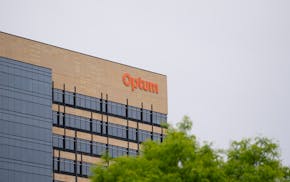Mikayla Deiter pays about $100 a month to feed her dog, Sunday, and that doesn't count extras like broth and treats.
So far, the high school teacher said prices for Blue Buffalo Wilderness blend dog chow have remained manageable. But if they keep climbing...
"I'd consider switching," Deiter said. "But he really likes this one."
Since February 2020, the cost of pet food — and human food, for that matter — has increased about 23%, according to federal data. While inflation has started slowing for groceries, the cost of kibble is still on the rise.
Pet owners know it's not always as simple as grabbing a cheaper bag to save money, however. It takes time for animals to adjust to new food, if they're willing to accept a replacement at all.
Julie Behr's dog, Finley, has a sensitive stomach, so it's Purina or bust.
"We stick with what works, no matter the cost," Behr said earlier this week at the Loring Park dog park in downtown Minneapolis. "It's not worth it to switch and have issues."
As a result of this common predicament, pet food — and especially cat food — has experienced less "trading down" to cheaper brands.
"Once pet parents start buying premium food for their dogs, they typically do not switch out," said Tiffany Putland, a former manager for Cargill's premium pet food business.
That has been a boon for other Minnesota companies like General Mills (Blue Buffalo) and Post Consumer Brands (Kibbles 'n Bits), which own five of the top-10 dry dog food brands in the U.S.
"We are selling everything that we can make, but we're not making enough," Post CEO Robert Vitale told analysts last month.
That's a refrain often heard from General Mills leaders as well, and it underscores one reason why pet food prices have increased. After a surge of adoptions during the pandemic, there are more dogs and cats to feed, and it is taking a while for companies to increase production to meet that demand.
Then, as these companies produce more pet food, they are bidding up prices on the limited availability of meat and veggies — plus packaging material, warehouse space and drivers — while trying to keep costs low so as not to scare off consumers.
"Brands don't want to risk losing customers from too high of a price point," Putland said.
That might be working so far. At the Dakota Dog Park in St. Louis Park this week, Scott Shaffer said higher pet food prices have barely fazed him.
"I noticed it went up by a couple of bucks, but it didn't register to me as, like, 'Oh man, inflation,'" he said as his red lab, Rosie, ran around the park. "Maybe I should be more outraged by it."
Why the increase?
Katherine Ellison has three dogs and two cats to feed and hasn't made any changes to their diets to deal with inflation. She and her husband, though, are cutting back on restaurants and food delivery.
"We have a lot of mouths to feed, but our pets are our kids," she said. "So we want to be feeding them the best food that works for them."
Ellison is also founder and CEO of Bright Planet Pet, a Minneapolis plant-based dog treat brand sold at 4,000 stores across North America. Being in the industry has helped her see what costs are passing on to consumers and why.
"Some consumers might not have noticed much inflation in their pet products until the second half of last year and into this year because of the way we receive price increases and ingredients," she said.
To deal with normal demand, manufacturers contract for a certain supply of ingredients and pay a set price for a set amount of time. It's the big spike in demand that's driving brands to race and catch up that has caused more expensive "spot" ingredient purchases, Ellison said.
The cost to make pet food has gone up about 30% since the start of the pandemic, according to the Bureau of Labor Statistics. Compared to the 23% price increases consumers are seeing, that means, on average, the companies aren't recouping all of the higher manufacturing costs through higher shelf prices.
Pet food manufacturers might continue to push out price increases to regain lost profit margins, or they could hope for relief in ingredient prices and supply chain issues.
Ellison absorbed as much as she could before raising prices this year.
"We can't continue to take those margin hits forever," she said. "It's not good for our business."
At Urban Tails Pet Supply in Minneapolis, it wasn't a matter of which brands increased prices but when they decided to do it. Treats were most affected, since they are more discretionary.
"In terms of customer numbers, we're serving the same number," store manager Jess Swartout said. "People mostly say: I guess this is how much it costs now."
Dry food dominates
Nationally, pet food and treat sales should reach $62.7 billion this year, an 8% increase from 2022.
Most of that growth will probably be in dry food, though fresh/refrigerated pet food is still rising despite its already higher prices.
Since pet parents aren't at home with their pets as often, "they're not topping up their dry food with wet as much as they would before," General Mills CEO Jeff Harmening said at an investor conference earlier this month.
"As consumers start to feel a little bit more pinched, wet pet food is more expensive," he said. "And I think that may struggle a little bit more."
While dollar sales are climbing overall in pet food largely because of price increases, the number of dry food bags sold inched up only slightly in the past year at U.S. retailers, according to Circana, a Chicago-based market research firm. Meanwhile, the number of wet food products sold has tanked.
Though pet parents often hang on to the name brand that works best, store brand and private label options have been increasing their market share as some make the switch.
"We aim to offer equivalent quality to national brands at a savings of at least 15-20%," said Hopkins-based UNFI brand manager Tom Johnson, who oversees the Wild Harvest and Essential Everyday lines found at Cub and other retailers. "Research also shows when shoppers do trade into private label, they tend to stick around in greater numbers."
Rachel Eason in St. Paul said both her senior cats are finicky eaters, and it was Kirkland Signature, Costco's house brand, that saved the day.
"Their dry food is a specific Science Diet blend that I have to pay premium for, and they will only eat wet food if it's in gravy, which can be very expensive, especially considering they change their minds daily about whether to hate it or not," she said.
Eason found the innovation she needed at Costco, which now sells cat food in gravy as opposed to the more typical pate style.
"You'd better believe I bought that up in bulk," she said. "Now they can be finicky all they want, and I don't have to wince each time I throw out uneaten, ever-increasingly expensive cat food in the trash."

UnitedHealth sues the Guardian, alleging defamation in coverage of nursing home care

Prices for international flights drop as major airlines navigate choppy economic climate
Minnesota's med spa industry rises in popularity — and with little regulation

Hundreds line up at Best Buy to nab Nintendo Switch 2, in scene like '90s opening parties



